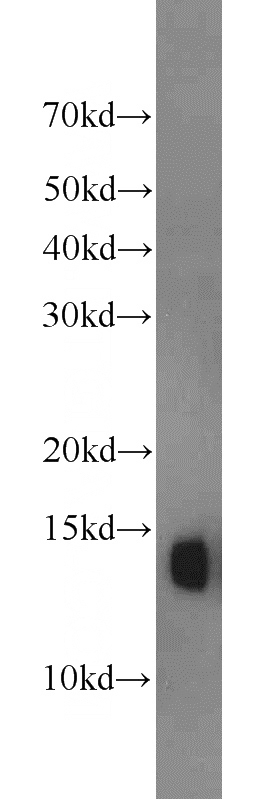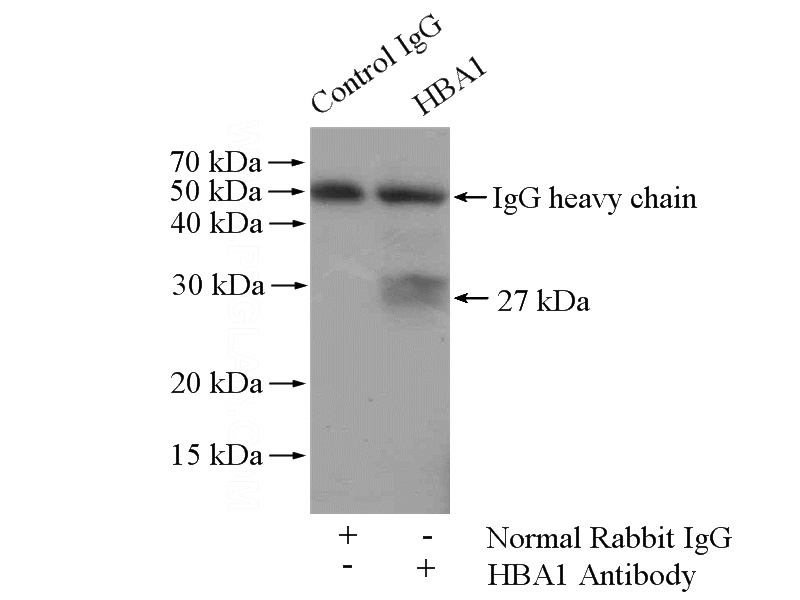-
Product Name
Hemoglobin alpha antibody
- Documents
-
Description
Hemoglobin alpha Rabbit Polyclonal antibody. Positive IP detected in mouse liver tissue. Positive WB detected in K-562 cells, mouse liver tissue, rat brain tissue, rat heart tissue. Observed molecular weight by Western-blot: 14-16 kDa, 27 kDa
-
Tested applications
ELISA, WB, IP
-
Species reactivity
Human, Mouse, Rat; other species not tested.
-
Alternative names
Alpha globin antibody; HBA1 antibody; HBA2 antibody; Hemoglobin a antibody; Hemoglobin alpha chain antibody; Hemoglobin subunit alpha antibody; hemoglobin antibody; alpha 1 antibody
-
Isotype
Rabbit IgG
-
Preparation
This antibody was obtained by immunization of Hemoglobin alpha recombinant protein (Accession Number: NM_000558). Purification method: Antigen affinity purified.
-
Clonality
Polyclonal
-
Formulation
PBS with 0.02% sodium azide and 50% glycerol pH 7.3.
-
Storage instructions
Store at -20℃. DO NOT ALIQUOT
-
Applications
Recommended Dilution:
WB: 1:500-1:5000
IP: 1:200-1:2000
-
Validations

K-562 cells were subjected to SDS PAGE followed by western blot with Catalog No:111287(HBA1 antibody) at dilution of 1:1000

IP Result of anti-HBA1 (IP:Catalog No:111287, 4ug; Detection:Catalog No:111287 1:500) with mouse liver tissue lysate 4000ug.
-
Background
The hemoglobin molecule is a tetramer consisting of two alpha- and two beta-globin-like chains. HBA1 (hemoglobin alpha chain) protein is a alpha-type chain of hemoglobin encoded by two independent genes (HBA1 and HBA2) whose coding sequences are identical. Two alpha chains coupled with two beta chains constitute the adult hemoglobin (HbA or α2β2). HBA1 is also the component of fetal hemoglobin (HbF or α2γ2). This antibody detects a major band around 14-16 kDa in the western blot analysis of heart tissue and K-562 cells. A higher band around 26-27 kDa can also be observed occasionally, which may represents the dimer form of HBA1 (20836851). This antibody may cross-react with other hemoglobin chains.
-
References
- Yang G, Shi W, Hu X. Therapeutic effects of induced pluripotent stem cells in chimeric mice with β-thalassemia. Haematologica. 99(8):1304-11. 2014.
- Homma T, Kurahashi T, Lee J, Kang ES, Fujii J. SOD1 deficiency decreases proteasomal function, leading to the accumulation of ubiquitinated proteins in erythrocytes. Archives of biochemistry and biophysics. 583:65-72. 2015.
Related Products / Services
Please note: All products are "FOR RESEARCH USE ONLY AND ARE NOT INTENDED FOR DIAGNOSTIC OR THERAPEUTIC USE"
